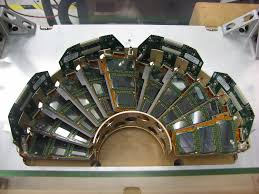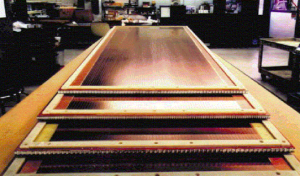The US CMS collaboration led by Fermilab made major contributions to the construction of the following detector sub-systems:
Pixel Tracker
The CMS pixel tracker forms the innermost part of the CMS detector. The pixel tracker provides precise space-point information that, along with the outer tracker, aids in the reconstruction of charged particles. The pixel modules provide two-dimensional position information, and the pixel hits serve as seeds for the tracking algorithms. By measuring charged particle trajectories, CMS can very precisely measure the kinematic properties of those particles and provide information on primary and secondary vertices. The technology used are pixelated silicon sensors, which are appropriate for the innermost layers of the tracking system but would be prohibitively expensive for the full tracker volume.
The pixel tracker is comprised of a barrel system (BPix) and two forward pixel (FPix) systems. The US CMS was responsible for constructing and delivering the FPix.
The U.S. institutes involved in the construction of the original forward pixel system included SUNY/Buffalo, Colorado, Cornell, Davis, Fermilab, Iowa, John Hopkins, Kansas, Mississippi, Nebraska, Northwestern, Purdue, Rutgers and Vanderbilt.
Strip Tracker
The outer all-silicon tracker of CMS is made up of silicon strip sensors and is built as a cylindrical barrel tracker system (inner and outer) and two end-cap systems. The US constructed all 5,208 of the tracker outer barrel (TOB) modules. These were assembled and tested at two production sites in the US: Fermilab and the University of California, Santa Barbara. The modules were delivered to CERN in the form of rods, with the last shipment taking place in August 2006. The 688 rods were then inserted into the TOB wheel by the integration team at CERN.
The institutes that participated in the TOB module and rod assembly and testing included Brown University, Fermilab, Kansas State University, the University of Kansas, the University of Illinois at Chicago, UC Riverside, Rochester University, UC Santa Barbara, and three groups from Mexico (Cinvestav, Puebla, and San Luis Potosi). The US CMS Outer Tracker group also contributed to the TOB integration effort and the Tracker Integration Facility Sector Test and is currently participating in the planned complete replacement of the outer tracker as part of the Phase-2 upgrade.
HCAL
The hadron calorimeter (HCAL) measures the energy of hadrons like protons, neutrons and kaons. HCAL is composed of 17 layers of brass (absorber) and plastic scintillator. An incident hadron interacts with a nucleus in the brass to create a shower of particles, which produces light in the scintillator in proportion to the energy of the hadron. Photosensors and custom electronics are mounted on the detector to measure the light, from which we can determine the energy of the original particle. This is also used to calculate any missing energy, carried off by weakly interacting particles such as neutrinos or some new particle, perhaps a dark matter candidate.
For the original HCAL, the U.S. CMS collaboration was responsible for procuring, preparing and assembling the barrel (HB) brass absorber and scintillator tiles and all of the HCAL front-end electronics, trigger, and readout. Fermilab mechanical engineers designed the brass absorber for HB. The active elements, the scintillator tiles, for HB were produced in the assembly buildings in the Fermilab Village, where they were cut, grooved, aluminized, and assembled into “megatiles.” Fermilab engineers designed, built and tested the front-end electronics, including the QIE ASIC.
The assembled and tested megatiles as well as the HB brass wedges built in industry were shipped to CERN where they were mated together. Front-end electronics were then installed, and the 18 wedges, weighing about 28.6 tons each were assembled into two large assemblies, HBP and HBM. The HB assemblies were the first detectors installed in the CMS underground collision hall.
Muon System
Muons are elementary particles, electrically charged, and are like electrons and positrons, only 200 times heavier. They are expected to be produced in decays of a number of other known unstable particles and potential new particles. Detecting muons is one of the most important tasks in CMS, as the name “Compact Muon Solenoid” suggests.
Muons can penetrate several meters of iron without interacting, and therefore, unlike most particles, they are not stopped by any of CMS’s calorimeters. Therefore, chambers to detect muons are placed outside of the solenoid, interleaved with the iron “return yoke” plates.
By tracking a particle’s path through the multiple layers of each muon station, combined with inner tracker measurements, the detectors can identify and make measurements of particle’s momentum. (Charged particles bend in a magnetic field, and how much it bends depends on the field and the particle momentum.) The CMS magnet is very powerful, so even the paths of very high-energy muons bend, and scientists can calculate their momenta.
In total there are 1,400 muon chambers: 250 drift tubes (DTs) and 540 cathode strip chambers (CSCs) track the particles’ positions and provide a trigger, while 610 resistive plate chambers (RPCs) form a redundant trigger system, which quickly decides whether to keep the acquired muon data or not. Because of the many layers of the detector and different specialities of each type, the system is robust and is able to filter out background noise.
DTs and RPCs are arranged in concentric cylinders around the beamline (“the barrel region”) while CSCs and RPCs make up the “endcap” disks that cover the ends of the barrel.
Trigger System
The CMS trigger system processes collision data from the CMS detectors in real time, receiving data from up to 1 billion distinct proton-proton (heavy ion) collisions per second, determining their critical properties and selecting events for further processing. The trigger system consists of two levels designed to select events that are potentially of physics interest. The first level of the trigger is implemented in hardware and selects events containing detector signals consistent with an electron, photon, muon, tau lepton, jet, or missing transverse energy. A programmable menu of up to 128 object-based algorithms is used to select events. The trigger thresholds are adjusted to the LHC instantaneous luminosity during data taking in order to restrict the output rate of the L1 trigger to 100 kHz, the upper limit imposed by the CMS readout electronics. The second level trigger, called the high-level trigger (HLT) is implemented in software (C++) running on commodity CPUs. The HLT further refines the selection and purity of the output stream and selects an average rate of 400 Hz for offline event storage.






